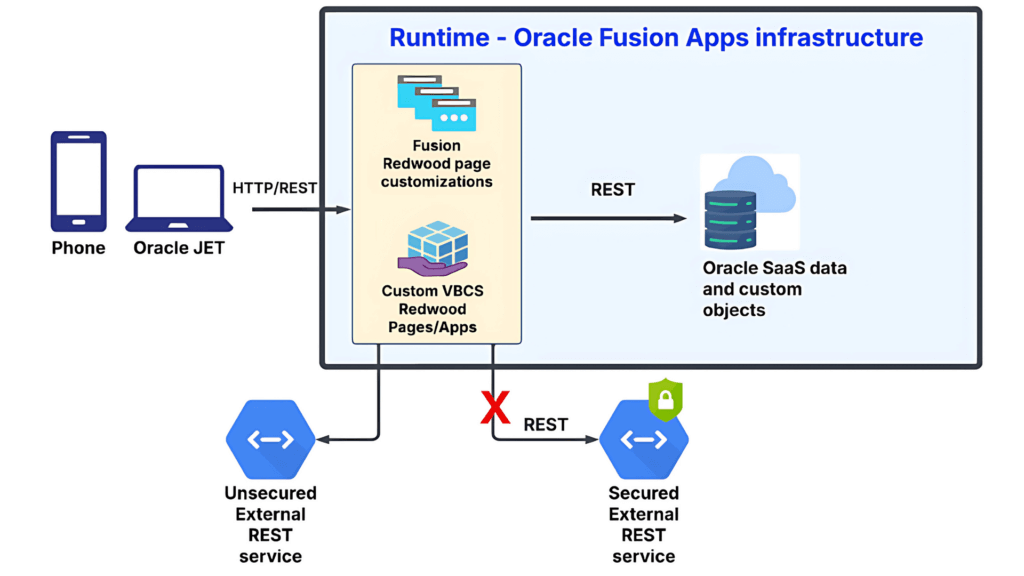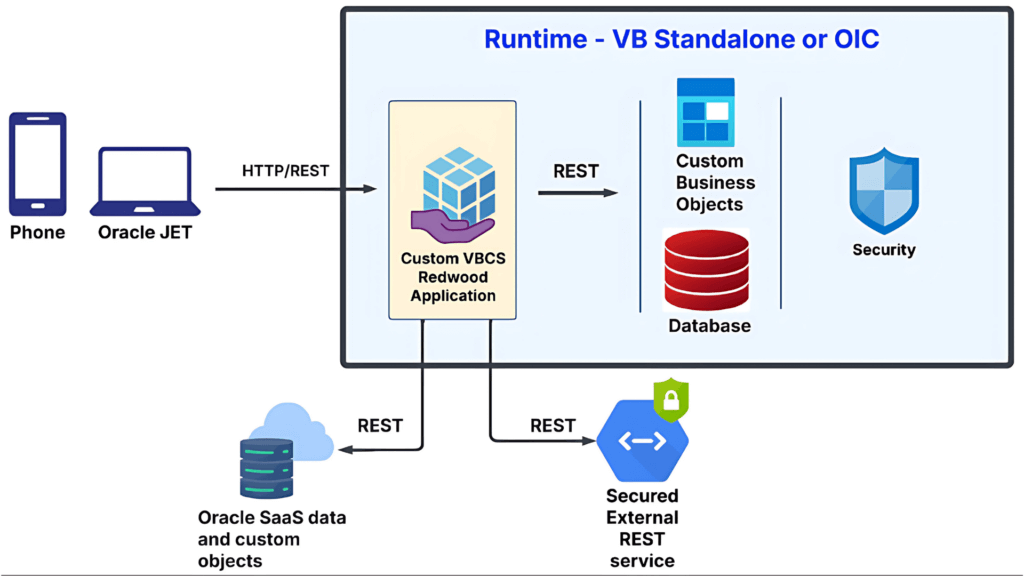Oracle VBCS Redwood Adoption
Oracle Visual Builder Cloud Service (VBCS) is the low-code development platform for extending Oracle Fusion Cloud Applications with Redwood UX. Whether modifying existing pages, creating new responsive applications, or integrating external data, VBCS provides a seamless development experience with modern methodologies like Git and CI/CD. Oracle has a roadmap to migrate all their Fusion applications to the Redwood user interface (UI) through Visual Builder Cloud Service (VBCS), with a plan to gradually transition all modules, including HCM, EPM, and Financials. VBCS development scenarios fall into three key categories:
- Modifying delivered Redwood pages in Oracle SaaS
- Creating new Redwood pages/apps in Oracle SaaS
- Creating bespoke apps mashing up Oracle SaaS and external data

Let’s review these three scenarios in more detail:
1. Modifying Delivered Redwood Pages in Oracle SaaS
Organizations often need minor tweaks to existing Fusion Cloud pages, such as adding fields, adjusting layouts, or enhancing functionality. With VBCS, these modifications:
- Are fully integrated within Fusion Apps – No additional installation or licensing is needed.
- Use the same security model – No iframe workarounds; changes remain within Fusion’s security layer.
- Leverage Redwood templates – Ensuring a consistent UX across applications.
- Have seamless access to Fusion Business Objects – Through the Service Catalog and App Composer custom objects.
- Are built with true visual development – Drag-and-drop UI building, visual logic, and declarative components.
- Provide direct code access – Enabling fine-tuned customization beyond visual development.
- Follow modern DevOps methodologies – Supporting Git and CI/CD for iterative development and automated deployments.
Example Use Case: A finance team wants an additional data table on the invoice approval page. With VBCS, developers can modify the Redwood UI, bind it to Fusion Business Objects, and deploy it without disrupting the SaaS environment.

2. Creating New Redwood Pages/Apps in Oracle SaaS
When standard Fusion pages don’t meet business needs, developers can create entirely new Redwood applications that seamlessly integrate with Fusion SaaS. These custom apps:
- Reside within Fusion Apps – No separate licensing or external servers required.
- Maintain the same user experience – Redwood templates ensure UI consistency.
- Securely access Fusion Business Objects – Via the built-in Service Catalog.
- Enable easy customization of Fusion objects – Through App Composer extensions.
- Support white-box development – Developers can directly modify the code while benefiting from a visual development experience.
- Are managed using CI/CD pipelines – Allowing automated testing and deployment through Git.
Example Use Case: A company wants a new employee onboarding app that integrates HR, IT, and Facilities workflows. A VBCS app can be built within Fusion, leveraging Fusion HCM and ERP services for a unified experience.  Note: You generally do not need additional licensing to extend Oracle Fusion Apps with new Redwood applications using the built-in customization tools like Oracle Visual Builder Cloud Service (VBCS) and runs within Fusion Apps Instance, which is included within your existing Fusion Applications license.
Note: You generally do not need additional licensing to extend Oracle Fusion Apps with new Redwood applications using the built-in customization tools like Oracle Visual Builder Cloud Service (VBCS) and runs within Fusion Apps Instance, which is included within your existing Fusion Applications license.
When Do You Need a Visual Builder Standalone Instance? A separate Visual Builder standalone instance is required when:
- Non-SaaS users need access to external partners, suppliers, or customers using the application.
- The app must run outside the Fusion context – Independent applications with unique domains.
- Integration with secured external data is needed – Connecting with third-party APIs requires authentication.
- A custom database is required – Apps need their own persistent data storage.
3. Creating Bespoke Apps Mashing Up Oracle SaaS and External Data
For organizations needing to integrate Fusion SaaS with external systems, VBCS enables the development of bespoke apps that:
- Can be embedded in Fusion Apps – One option is using an iframe for seamless integration.
- Run on a separate Visual Builder Server – Independent from Fusion SaaS.
- Provide additional capabilities, such as:
- External REST authentication protocols for third-party API integration.
- Custom business objects and a built-in database for tailored data models.
- Apps accessible to non-SaaS users, such as external partners or customers.
- Standalone deployment, including custom domains for independent branding.
- Fully customized UI beyond standard Redwood templates.
- Use the same VBCS development environment – Ensuring consistency across Fusion and external apps.
- Enable seamless Fusion integration – Through identity propagation and single sign-on, maintaining roles and security settings.
Example Use Case: A logistics company wants a supplier portal that integrates Fusion SCM data with external tracking APIs. A bespoke VBCS app can be built, hosted separately, and securely connected to Fusion via REST services. 
Conclusion Oracle VBCS Redwood development provides a powerful and flexible framework for extending Fusion SaaS applications. Whether modifying existing pages, building new integrated apps, or developing bespoke solutions with external data, VBCS ensures a seamless, secure, and scalable development experience. With built-in Git, CI/CD, and identity propagation, organizations can innovate faster while maintaining enterprise-grade security and performance.
